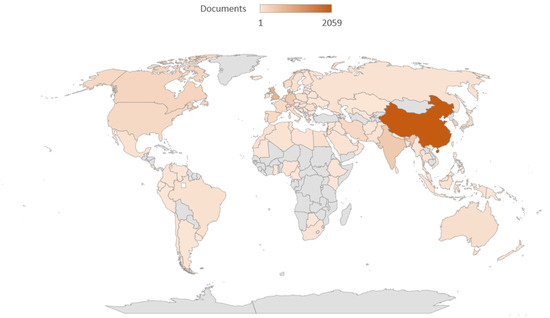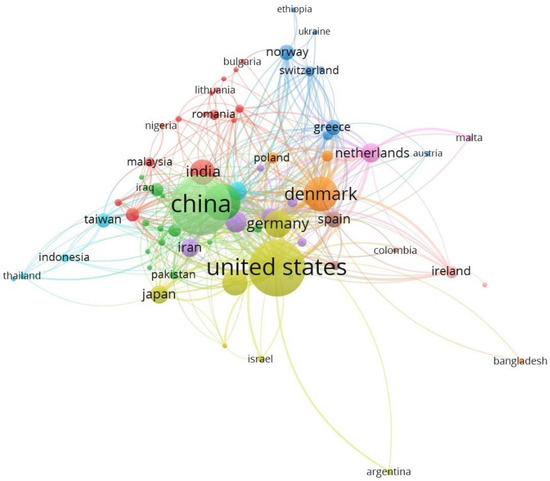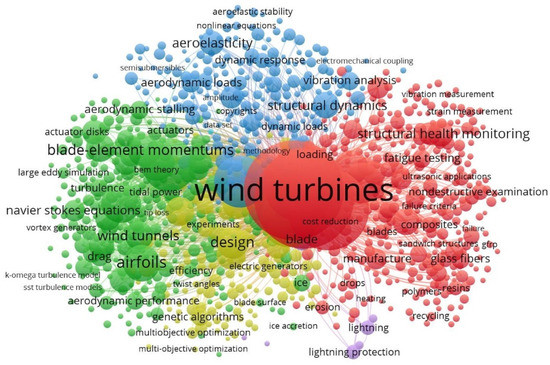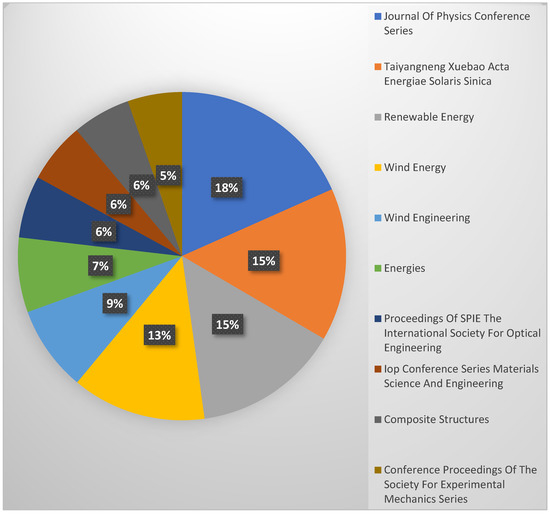1. Introduction
In a world in which electricity is increasingly necessary, it is vitally important to ensure that the supply of this electricity is safe, reliable, sustainable, and environmentally friendly, reducing CO2 emissions into the atmosphere and the use of fossil fuels. Renewable energies, and wind energy, in particular, make a significant contribution to this. Wind energy research dates to the last century, yet efforts to improve wind turbine performance continue around the world. Advances in blade aerodynamics and wind resource assessment are outstanding [1].
According to some authors, such as Haase et al. [2] who state that fossil fuels should be replaced and to combat climate change with renewable energies, or Yang et al. [3] who studied that three forms can be used to improve energy transmission: high voltage alternating current transmission, high voltage direct current transmission, and low-frequency alternating current. Ma et al. [4] used the Weather Research Forecasting (WRF) model to forecast the future wind potential, observing that in the next few years the potential will decrease in the center of the country and in Eastern Quebec, and in the Great Lakes it will increase; Niyomtham et al. [5] also proposed to consider electricity tariffs when evaluating the wind resource.
The aerodynamic loads must be studied as well as its design; for this, Blade Element Momentum (BEM) is indispensable to determine the aerodynamics of the wind turbine blade. However, because it is not easy to calculate, the BEM is used with the use of Computational Fluid Dynamics (CFD) in its 2D version. This was performed by Sang et al. [6], who used the classical BEM model and the modified BEM, and found that by combining them they were able to correct the aerodynamics of their model. Kavari et al. [7] demonstrated that using other variables for the evaluation of an airfoil is of great interest. In this study they used wind shear, in addition to BEM and drag and lift coefficients; the results showed that at low wind shear the power output increased, and the kinetic energy was reduced.
Several studies have been conducted on lift and drag forces. These forces are important in the aerodynamic analysis of wind turbine blades, such as the analysis performed by Oukassou et al. [8], who evaluated an airfoil with different Reynolds numbers and found the optimal chord dimension and angle of attack. An interesting proposal is hybrid blades, such as the one proposed by Yen et al. [9], who used several flows with different Reynolds numbers and different angles of attack; in this study they were able to increase the lift coefficient to twice the normally measured ones. Hasham Ali et al. [10] proposed lift and drag coefficients for low speeds on vertical axis wind turbines to identify the best airfoil; they identified that for low speeds the angle of attack should be changed from 0° to 15°.
Much more research could be enunciated; however, proposals are presented here to further improve the wind industry.
- Mini wind.
- Blade Element Momentum.
- Wind resource assessment.
- Blade diffusers.
- Mesoscale and microscale simulations.
2. Worldwide Research Trends on Optimizing Wind Turbine Efficiency
In this study, the Scopus database was used to analyze the current state of knowledge on optimizing wind turbine efficiency using bibliometric techniques.
The research starts using the following research equation: TITLE-ABS-KEY(“Wind Turbine Blade”) OR TITLE-ABS-KEY(Optimization Flexible Blade*) OR TITLE-ABS-KEY(“wind turbine deformable profile”) OR TITLE-ABS-KEY(“Wind Turbine Efficiency”) OR TITLE-ABS-KEY(“Blade element momentum”) OR TITLE-ABS-KEY(“Wind turbine trends”) with the objective to obtain results about documents type, scientific production, the most important scientific institutions and their scientific productions, the current collaboration between countries, the most important authors, and the use of keywords.
Currently, there are about 9315 manuscripts on optimizing wind turbine efficiency; the countries with the most research are China, the United States of America, the United Kingdom, Denmark, and Germany. Figure 1 shows the top ten countries on the topic.

Figure 1.
Worldwide top ten countries on optimizing wind turbine efficiency.
To determine the collaboration between authors from different countries related to the same subject, the application VOSviewer has been used. This application records the download data from the Scopus database and delivers a *.csv file; this relationship can be appreciated in Figure 2. The color assigned to each country determines which cluster it belongs to. The size of the circle shows the importance of the country based on the number of publications on renewable energy and agriculture, and the lines represent the collaborations in scientific documents existing between the different countries that form each cluster.

Figure 2.
Worldwide collaborations between countries on optimizing wind turbine efficiency.
In the same way, the Vosviewer software was used to find out the different clusters of keywords that coincide simultaneously in different publications, in such a way that it helps us to find out the trend in research and the themes in which the keywords are grouped. Figure 3 shows five keyword clusters detected in the different publications obtained in Scopus on optimizing wind turbine efficiency.

Figure 3.
Keyword clusters on optimizing wind turbine efficiency.
Table 1 shows for each cluster: the color, the main words, and the topic.

Table 1.
Main clusters obtained in the co-words analysis on the topic of wind turbine efficiency.
The top ten journals that have published the highest number of articles on optimizing wind turbine efficiency are shown in Figure 4. It is worth highlighting the relevant position of the journal Energies at number 7.

Figure 4.
Worldwide top ten journals on optimizing wind turbine efficiency.
If the search equation is limited to optimizing wind turbine efficiency publications in the Energies journal (TITLE-ABS-KEY(“Wind Turbine Blade”) OR TITLE-ABS-KEY(Optimization Flexible Blade*) OR TITLE-ABS-KEY(“wind turbine deformable profile”) OR TI-TLE-ABS-KEY(“Wind Turbine Efficiency”) OR TITLE-ABS-KEY(“Blade element mo-mentum”) OR TITLE-ABS-KEY(“Wind turbine trends”) AND (LIMIT-TO(EXACTSRCTITLE, “Energies”)), 125 documents are obtained. Table 2 shows the top ten countries that have published the most on the topic in the Energies journal.

Table 2.
Top ten countries that have published the most on the topic in the Energies journal.
3. Most Cited Articles in Energies Journal on Optimizing Wind Turbine Efficiency
The improvements range from acting on the cut-in-speed and rated speed to improving the design of wind turbine blades by minimizing physical, geometric, and aerodynamic constraints that improve the power coefficient and annual energy yield. In this sense Rehman et al. conducted a review of articles that focus on the different ways to improve the efficiency of wind turbines [11]. The authors’ review focuses mainly on the work carried out to improve blade design through experimental and analytical methodologies. Previously, other authors have worked in the same direction.
Schubel and Crossley reviewed the design of wind turbine blades by considering parameters such as theoretical maximum efficiency, propulsion, practical efficiency, design, and blade loads, highlighting the almost exclusive use of rotors with horizontal shafts, and then detailing and reviewing the aerodynamic principles used in the design of modern turbines [12].
Hsiao et al. (2013) experimentally and numerically analyzed three blade models. For this study, they used a wind tunnel and fluid dynamics software with the k-ω type turbulent model. In both studies, they calculated the power coefficient and the velocity ratio. Given the proximity between the experimentally and numerically calculated power coefficient values, the authors suggested the numerical method as a good approximation for the full-scale study of wind turbines [13].
Tran et al. studied the aerodynamic effects on a floating offshore wind turbine with pitching motion, described as a sine function. The study was carried out by applying Reynolds average Navier-Stokes with a k-ω turbulent model. The results were compared with previous studies and it was concluded that the aerodynamic loads varied with the frequency and amplitude of the platform motion [14].
Chen et al. investigated the failure causes in the transition zone of wind turbine blades by applying a Finite Element (FE) simulation, which was performed using a global-local modeling approach and Progressive Failure Analysis (PFA) techniques to detect accumulated delamination, at the spar cap, and shear web failure, in the transition region, which were the main causes for blade collapse [15].
Masters et al. conducted a comparative study of numerical models applied to tidal stream turbines to obtain renewable energy from the ocean. The models used were blade element momentum theory (BEMT), blade element actuator disk, Reynolds averaged Navier Stokes (RANS) CFD (BEM-CFD), blade-resolved moving reference frame, and coastal models based on shallow water equations. The results obtained, for the turbine fence case, were similar to the BEM-CFD and coastal models [16].
Gómez Muñoz and García Márquez demonstrated the use of low-cost acoustic sensors to detect failures in the microfibres of wind turbine blades. They employed a robust monitoring system (CMS) together with new signal processing software [17].
Nielsen and Sorensen proposed the use of dynamic Bayesian networks to optimize and plan maintenance tasks on wind turbine blades. They used data from previous inspections of a range of blades to calibrate a Markov model that was then applied to a particular blade model [18].
Fernández-Gámiz et al. investigated the installation of two flow control systems, vortex generators and gurney flaps, to increase the power output of a 5 MW turbine. The study was performed using the BEM method for different wind speeds and showed that the blades with the flow control systems increased the power output of the turbine [19].
Schramm et al. studied the influence of erosion on the edge of wind turbine blades. They compared eroded blades with blades protected against this phenomenon by calculating polar aerodynamics using computational fluid dynamics and load calculations using BEM. They concluded that the eroded blades caused a power loss of 9%, while the power reduction in the protected blades was only 1% [20].
Arcos Jiménez et al. focused their work on the processing of guided lamb wave signals and multiclass pattern recognition using machine learning to detect, at an early stage, the delamination of wind turbine blade material, which is the source of cracks and partial or total breakage. To test the approach, the delamination phenomenon was provoked using wavelet transforms, which are effective in eliminating noise and extracting the characteristics of the measured signal [21].
Author Contributions
Conceptualization, A.A., Q.H.-E., D.M.-R. and A.-J.P.-M.; methodology, A.A., Q.H.-E., D.M.-R. and A.-J.P.-M.; investigation, A.A., Q.H.-E., D.M.-R. and A.-J.P.-M.; writing—original draft preparation, A.A., Q.H.-E., D.M.-R. and A.-J.P.-M. All authors have read and agreed to the published version of the manuscript.
Funding
This research received no external funding.
Conflicts of Interest
The authors declare no conflict of interest.
References
- Castillo, A.D.; Jauregui-Correa, J.C.; Herbert, F.; Castillo-Villar, K.K.; Franco, J.A.; Hernandez-Escobedo, Q.; Perea-Moreno, A.-J.; Alcayde, A. The Effect of a Flexible Blade for Load Alleviation in Wind Turbines. Energies 2021, 14, 4988. [Google Scholar] [CrossRef]
- Haase, M.; Wulf, C.; Baumann, M.; Rösch, C.; Weil, M.; Zapp, P.; Naegler, T. Prospective Assessment of Energy Technologies: A Comprehensive Approach for Sustainability Assessment. Energy Sustain. Soc. 2022, 12, 20. [Google Scholar] [CrossRef]
- Yang, B.; Liu, B.; Zhou, H.; Wang, J.; Yao, W.; Wu, S.; Shu, H.; Ren, Y. A Critical Survey of Technologies of Large Offshore Wind Farm Integration: Summary, Advances, and Perspectives. Prot. Control Mod. Power Syst. 2022, 7, 17. [Google Scholar] [CrossRef]
- Ma, X.; Li, Y.; Li, Z. The Projection of Canadian Wind Energy Potential in Future Scenarios Using a Convection-Permitting Regional Climate Model. Energy Rep. 2022, 8, 7176–7187. [Google Scholar] [CrossRef]
- Niyomtham, L.; Waewsak, J.; Kongruang, C.; Chiwamongkhonkarn, S.; Chancham, C.; Gagnon, Y. Wind Power Generation and Appropriate Feed-in-Tariff under Limited Wind Resource in Central Thailand. Energy Rep. 2022, 8, 6220–6233. [Google Scholar] [CrossRef]
- Sang, S.; Wen, H.; Cao, A.X.; Du, X.R.; Zhu, X.; Shi, Q.; Qiu, C.H. Dynamic Modification Method for BEM of Wind Turbine Considering the Joint Action of Installation Angle and Structural Pendulum Motion. Ocean. Eng. 2020, 215, 107528. [Google Scholar] [CrossRef]
- Kavari, G.; Tahani, M.; Mirhosseini, M. Wind Shear Effect on Aerodynamic Performance and Energy Production of Horizontal Axis Wind Turbines with Developing Blade Element Momentum Theory. J. Clean. Prod. 2019, 219, 368–376. [Google Scholar] [CrossRef]
- Oukassou, K.; Mouhsine, S.E.; Hajjaji, A.E.; Kharbouch, B. Comparison of the Power, Lift and Drag Coefficients of Wind Turbine Blade from Aerodynamics Characteristics of Naca0012 and Naca2412. Procedia Manuf. 2019, 32, 983–990. [Google Scholar] [CrossRef]
- Yen, S.-C.; Liu, W.-S.; San, K.-C.; Wang, W.-F. Design of Wind-Turbine Blades for Improving Aerodynamic Performance Using Hybrid Blades. Ocean. Eng. 2021, 227, 108889. [Google Scholar] [CrossRef]
- Hasham Ali, M.; Nawazish Mehdi, S.; Naik, M.T. Comparative Analysis of Low Velocity Vertical Axis Wind Turbine NACA Blades at Different Attacking Angles in CFD. Mater. Today Proc. 2021, in press. [Google Scholar] [CrossRef]
- Rehman, S.; Alam, M.M.; Alhems, L.M.; Rafique, M.M. Horizontal Axis Wind Turbine Blade Design Methodologies for Efficiency Enhancement—A Review. Energies 2018, 11, 506. [Google Scholar] [CrossRef]
- Schubel, P.J.; Crossley, R.J. Wind Turbine Blade Design. Energies 2012, 5, 3425–3449. [Google Scholar] [CrossRef]
- Hsiao, F.-B.; Bai, C.-J.; Chong, W.-T. The Performance Test of Three Different Horizontal Axis Wind Turbine (HAWT) Blade Shapes Using Experimental and Numerical Methods. Energies 2013, 6, 2784–2803. [Google Scholar] [CrossRef]
- Tran, T.; Kim, D.; Song, J. Computational Fluid Dynamic Analysis of a Floating Offshore Wind Turbine Experiencing Platform Pitching Motion. Energies 2014, 7, 5011–5026. [Google Scholar] [CrossRef]
- Chen, X.; Zhao, W.; Zhao, X.L.; Xu, J.Z. Failure Test and Finite Element Simulation of a Large Wind Turbine Composite Blade under Static Loading. Energies 2014, 7, 2274–2297. [Google Scholar] [CrossRef]
- Masters, I.; Williams, A.; Croft, T.N.; Togneri, M.; Edmunds, M.; Zangiabadi, E.; Fairley, I.; Karunarathna, H. A Comparison of Numerical Modelling Techniques for Tidal Stream Turbine Analysis. Energies 2015, 8, 7833–7853. [Google Scholar] [CrossRef]
- Gómez Muñoz, C.Q.; García Márquez, F.P. A New Fault Location Approach for Acoustic Emission Techniques in Wind Turbines. Energies 2016, 9, 40. [Google Scholar] [CrossRef]
- Nielsen, J.S.; Sørensen, J.D. Bayesian Estimation of Remaining Useful Life for Wind Turbine Blades. Energies 2017, 10, 664. [Google Scholar] [CrossRef]
- Fernandez-Gamiz, U.; Zulueta, E.; Boyano, A.; Ansoategui, I.; Uriarte, I. Five Megawatt Wind Turbine Power Output Improvements by Passive Flow Control Devices. Energies 2017, 10, 742. [Google Scholar] [CrossRef]
- Schramm, M.; Rahimi, H.; Stoevesandt, B.; Tangager, K. The Influence of Eroded Blades on Wind Turbine Performance Using Numerical Simulations. Energies 2017, 10, 1420. [Google Scholar] [CrossRef] [Green Version]
- Arcos Jiménez, A.; Gómez Muñoz, C.Q.; García Márquez, F.P. Machine Learning for Wind Turbine Blades Maintenance Management. Energies 2018, 11, 13. [Google Scholar] [CrossRef] [Green Version]
Publisher’s Note: MDPI stays neutral with regard to jurisdictional claims in published maps and institutional affiliations. |
© 2022 by the authors. Licensee MDPI, Basel, Switzerland. This article is an open access article distributed under the terms and conditions of the Creative Commons Attribution (CC BY) license (https://creativecommons.org/licenses/by/4.0/).